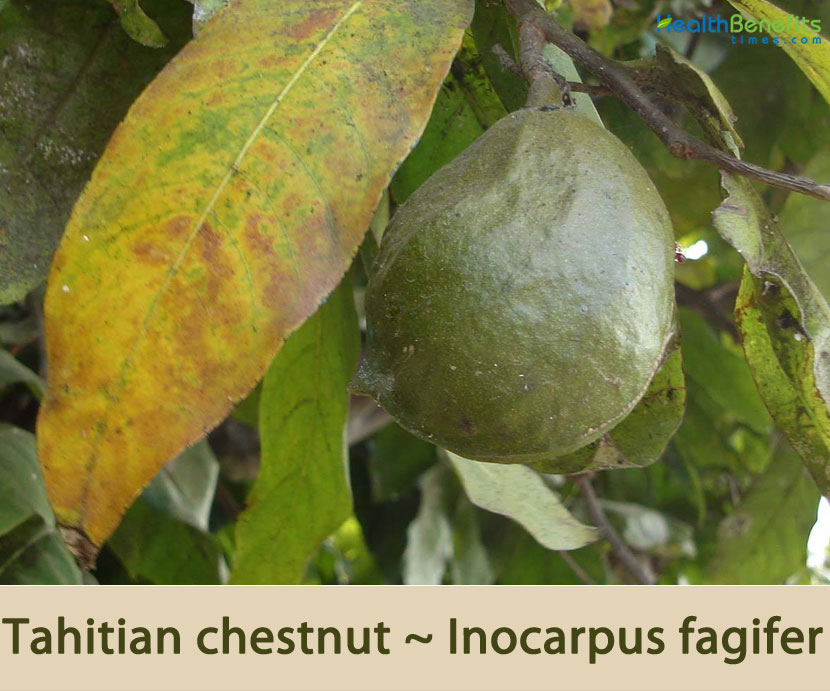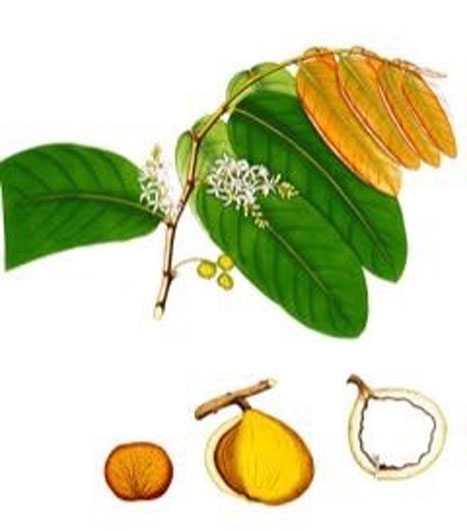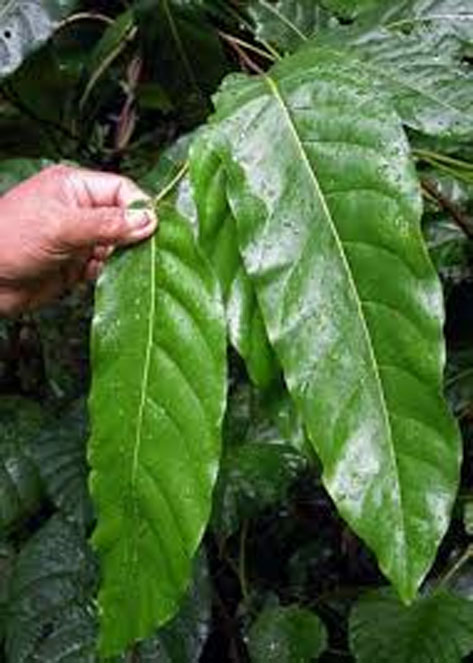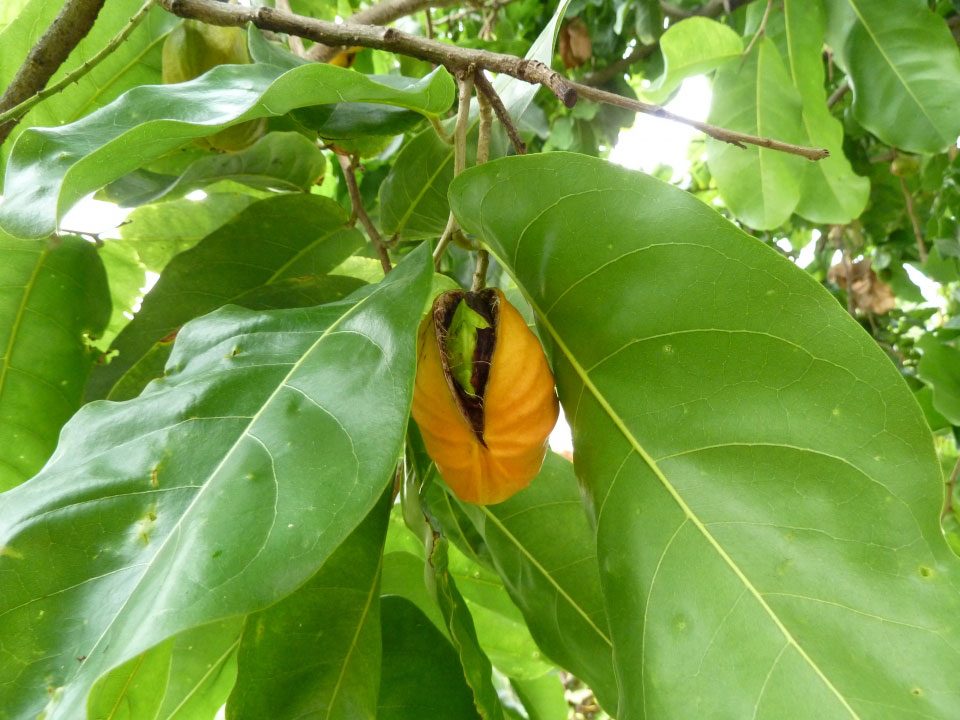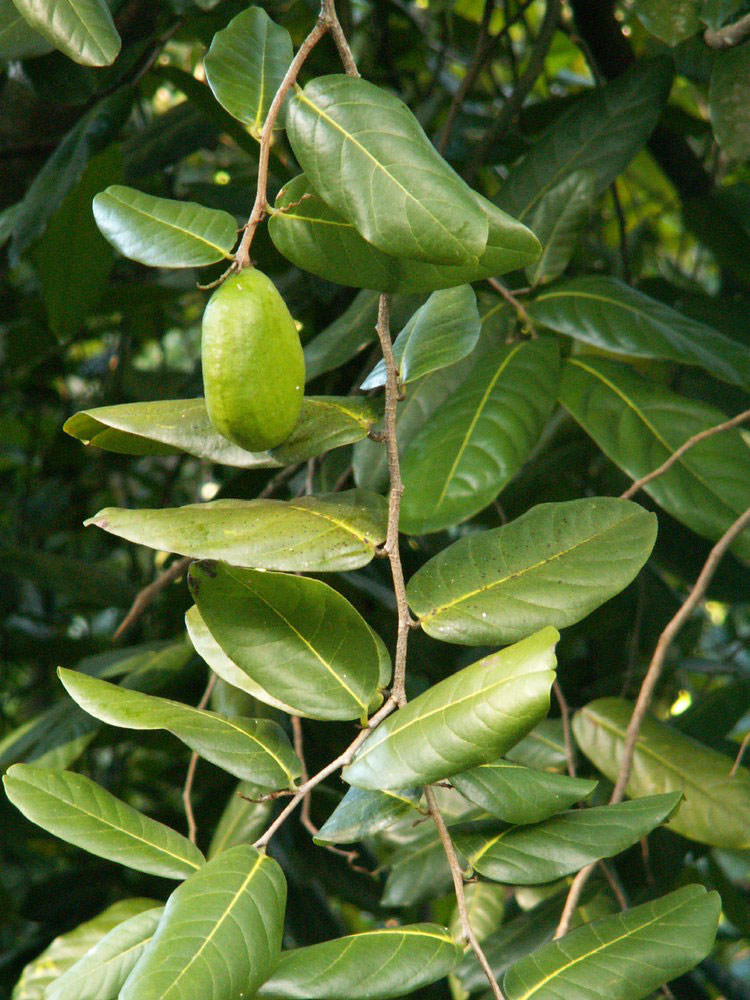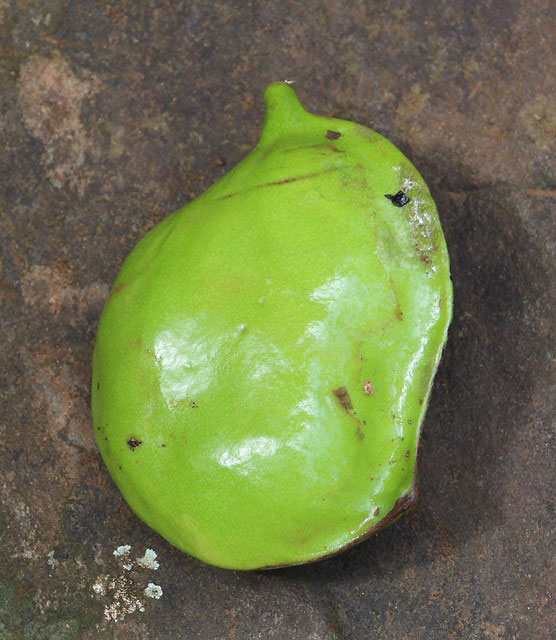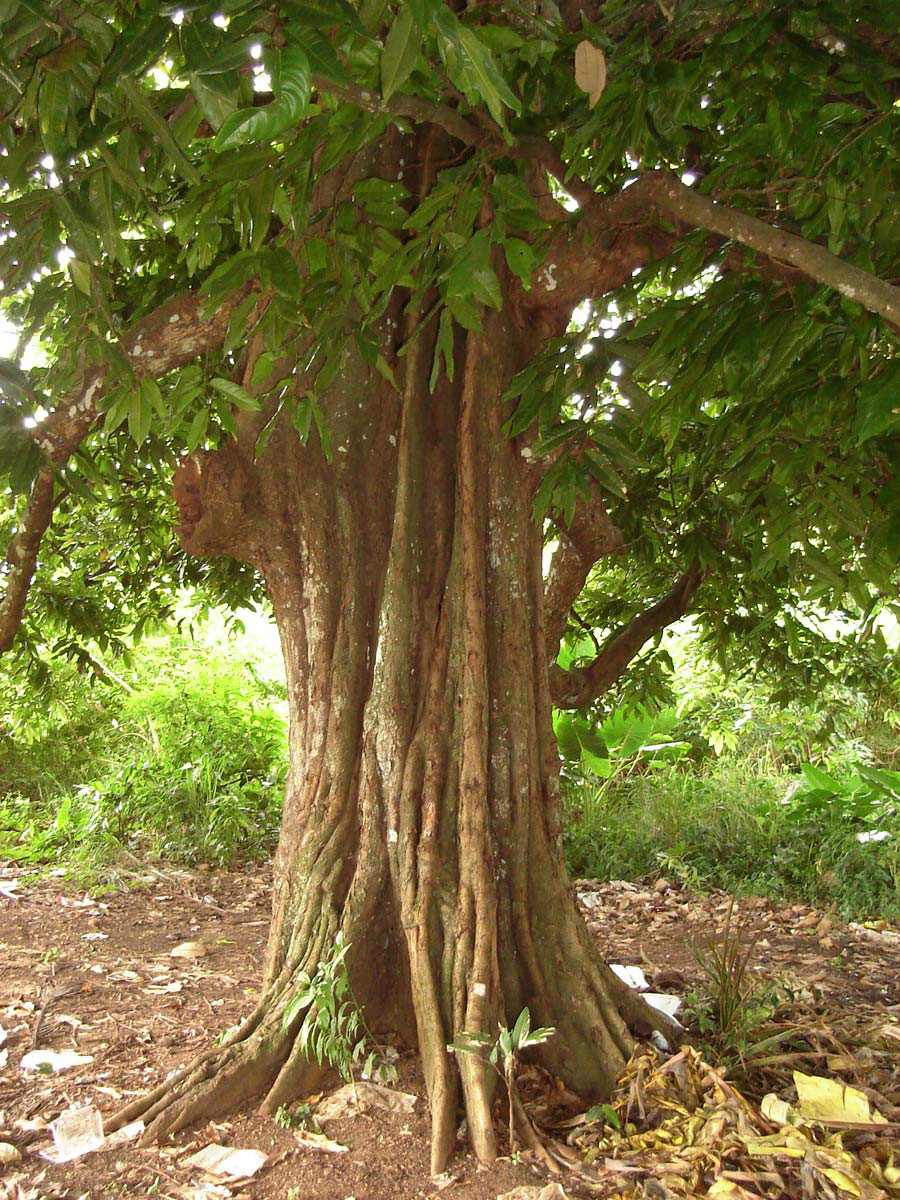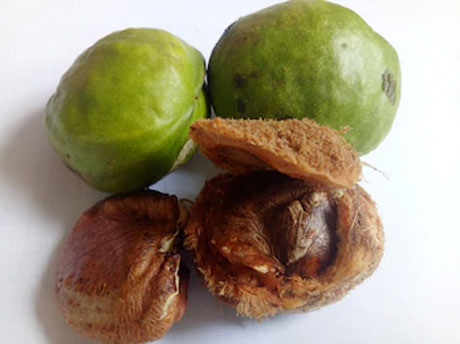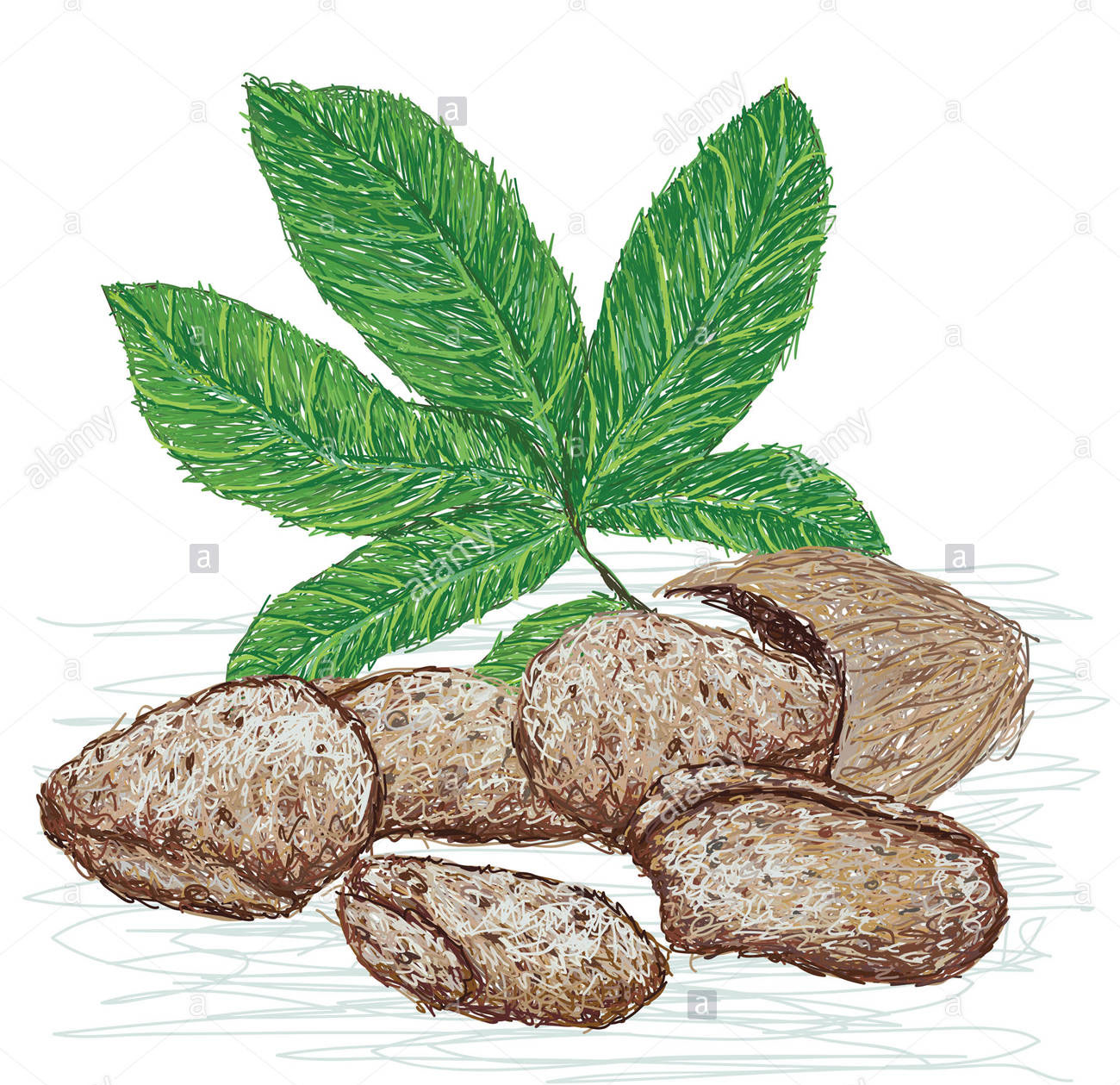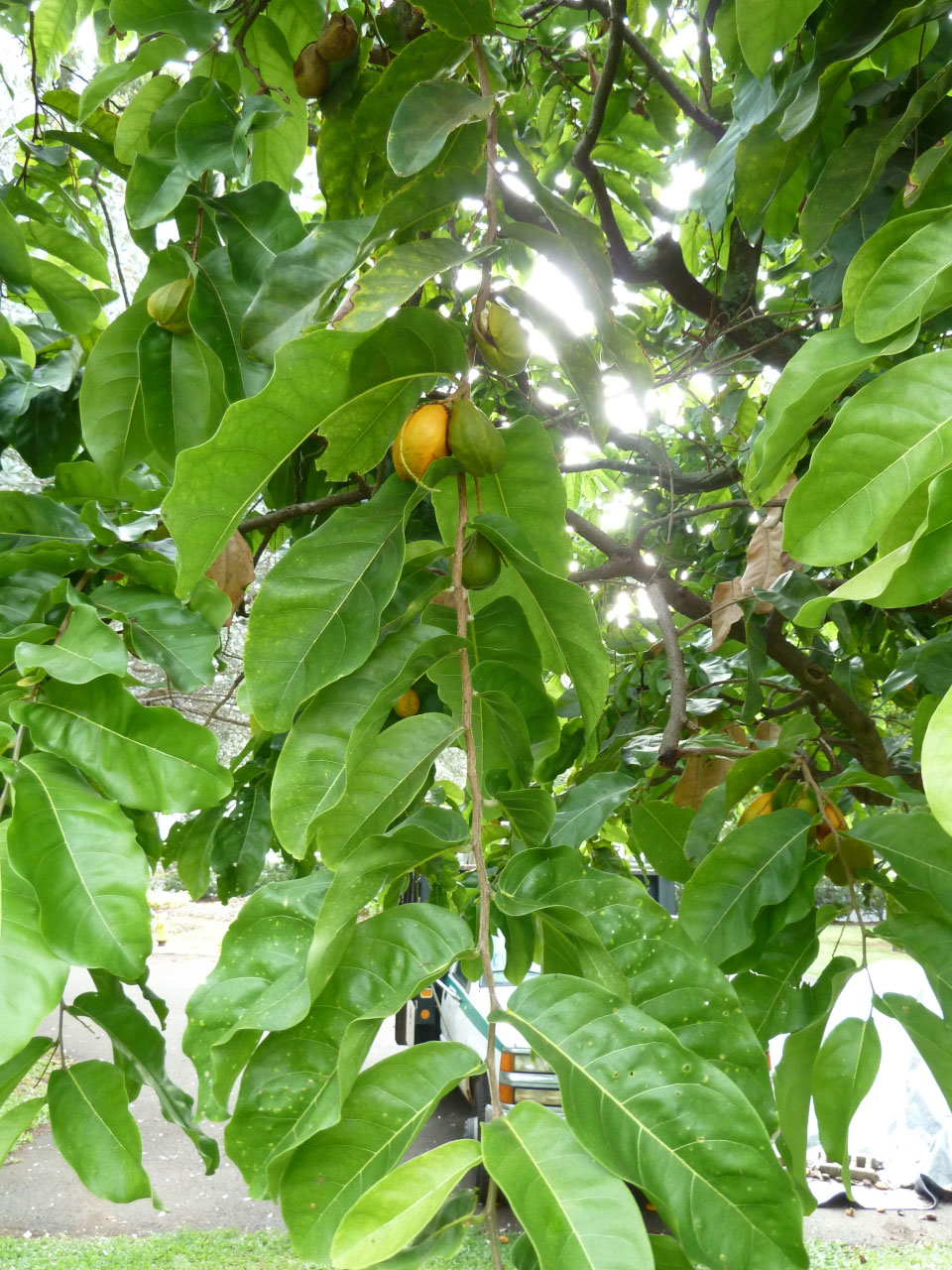Tahitian Chestnuts Facts
| Tahitian chestnut Quick Facts | |
|---|---|
| Name: | Tahitian chestnut |
| Scientific Name: | Inocarpus fagifer |
| Origin | Indo-Malaysia and is naturalized after ancient aboriginal introduction in Micronesia, Melanesia and Polynesia |
| Colors | Green skin color when raw turning to yellow or orangey-yellow when ripe |
| Shapes | Indehiscent pod, oblong to oval with oblique apex and compressed laterally, 4.5– 13 cm by 3.5–12 cm |
| Health benefits | Cures diarrhea, Clean intestines, Source of antioxidants, Treat canker sores, Maintain healthy skin, Helps food absorption |
| Name | Tahitian chestnut |
|---|---|
| Scientific Name | Inocarpus fagifer |
| Native | Indo-Malaysia and is naturalized after ancient aboriginal introduction in Micronesia, Melanesia and Polynesia (extending to the Marquesas). It is cultivated in the Pacific islands as well as in New Guinea, Indonesia, especially Java and Sulawesi, the Philippines and occasionally in the neotropics |
| Common Names | Tahiti Chestnut, Polynesian Chestnut, Otaheite Chestnut, Ailali, Arau, Booi, Dola, Dulafa, Gatet, Gayam, Gnuilaba, I’i, Ifi, Ihi, Isi, Ivi, Julapa, Kayam, Keam, Kurak, Mabe, Mape, Marap, Marare, Marau, Mwaqe, Mworopw, Namambe, Naqi, Nokomo, Nyia oki, Otaheite chestnut, Paravu, Paravua, Rata, Te ibi, Te karaka, Tolok, Zulapa |
| Name in Other Languages | Chinese: Tai ping yang li (太平洋栗 ) Chuukese : Asas, Kurek English: Otaheite chestnut, Polynesian chestnut, Tahiti chestnut, Tahitian Chestnut Fijian: Drala Kaka, Ivi, Ifi, Te Ibi Finnish: Tahitinmapepapu French: Châtaigne de Tahiti, Châtaignier de Tahiti, Inocarpe comestible, Mapé, Chataignier Tahitien German: Tahitikastanie, Tahiti-Kastanienbaum Horne Islands : Ifi Indonesian: Gayam, Gatep, Ghajam, Bosua, Gatet Japanese: Taiheiyou kurumi (タイヘイヨウクルミ), Gayam, Tolok Javanese: Gayam Kosraen : Kurrak Madurese: Ghajam Malay: Bosua (Sulawesi), Gatep (Bali), Gayam Malaysia : Tolok Marquesas : Ihi Niue : Ifi Papua New Guinea: Aila Philippines : Kayam Pohnpei: Mworopw, mwourup, mwuropw, mwoaroapw Russian: Inokarpus s”yedobnyy (Инокарпус съедобный), Taytyanskyy kashtan (Таитянский каштан) Samoa: Gatae, Ifi Society Islands : Mape Solomon Islands : Julapa In Bugotu, Zulapa In Zabana, Ivi, Komo, Mwaqe, Ailali, Dulafa, Dola, Ivi, Marovo, Naqi Sudanese: Gatet, Gayam Tagalog: Kayam Tahitian: Mape, rata Taiwan: Tai Ping Yang Li Tonga : Ngatae Fisi, Ifi Unidentified: Aila, Ifi, Ivi, Kerepit, Kopit, Lala Uvea : Ifi Vanuatu: Namambe Yapese: Bu’oy |
| Plant Growth Habit | Medium size, leguminous, evergreen tropical tree |
| Growing Climates | Common in coastal forests, margins of swampy places, along rivers, dry forest, lowland secondary forest, stream banks, swamps and marshes, mangrove areas, and coconut plantations, home gardens, lowland seaside forest, waterlogged areas, and highly alkaline soils along shorelines |
| Soil | Tolerates a wide range of soils from mildly acidic to very alkaline or saline coastal soils, from free draining soils to impeded drainage as well as seasonally waterlogged or even continually waterlogged soils. It tolerates soils of low to medium fertility, and can grow in a wide pH range of 5 mildly acid to pH 14 strongly alkaline soils |
| Plant Size | About 20 m (66 ft.) in height, though it can reach heights of 30 meters or more with bole of up to 7 – 90 cm (3–35 in) in diameter |
| Root | Shallow taproot and well-formed network of lateral roots |
| Bole | Short, thick, irregular, and very fluted |
| Bark | Bark is rough, flaky and brown, increasing gray with age |
| Leaf | Simple, oblong, alternately arranged, dark green, and leathery to the touch. They are 16–39 cm (6.3–15 in) long and 7–13 cm (2.8–5.1 in) in wide, and the petiole is 0.5–2.5 cm (0.2–1 in) long |
| Flowering season | November–December |
| Flower | Fragrant and clustered along a short rachis found at the apex of branches, stems, and twigs. They are about 1 cm (0.4 in) long and have five petals that vary from white to cream to pale yellowish |
| Fruit Shape & Size | Fruits are irregularly ovoid, slightly flattened, and rounded or oblong with a flange down one end. They are produced either singly or in clusters. Fruits weigh nearly 50–110 g (1.8–3.9 oz.) and measure 46–130 mm (1.8–5.1 in) in length, 34–120 mm (1.3–4.7 in) in width, and 40 mm (1.6 in) in thickness |
| Fruit Color | Green skin color when raw turning to yellow or orangey-yellow when ripe |
| Seed | White, kidney-shaped seed or kernel is contained in a fibrous, brownish, relatively thin about 2–3 mm (0.08 in) thick shell |
| Lifespan | Up to 90 years |
| Propagation | By seed, air-layering and stem cuttings |
| Plant Parts Used | Bark, leaves, seeds |
| Season | January–February |
| Health Benefits |
|
Plant Description
Tahitian chestnut is a medium size, leguminous, evergreen tropical tree that normally grows about 20 m (66 ft.) in height, though it can reach heights of 30 meters or more with short, thick, irregular, and very fluted bole of up to 7 – 90 cm (3–35 in) in diameter. The plant is found growing in coastal forests, margins of swampy places, along rivers, dry forest, lowland secondary forest, stream banks, swamps and marshes, mangrove areas, and coconut plantations, home gardens, lowland seaside forest, waterlogged areas, and highly alkaline soils along shorelines. The plant tolerates a wide range of soils from mildly acidic to very alkaline or saline coastal soils, from free draining soils to impeded drainage as well as seasonally waterlogged or even continually waterlogged soils. It tolerates soils of low to medium fertility, and can grow in a wide pH range of 5 mildly acid to pH 14 strongly alkaline soils. It has medium to high tolerance of steady and strong winds and is wind firm due to a strong lateral root system including buttresses. The plant has shallow taproot and well-formed network of lateral roots. The bark is rough and flaky and varies from brown to grayish. The grayish color is more common in older trees. Other bark characteristics appear relatively constant with age.
Leaves
The leaves are simple, oblong, alternately arranged, dark green, and leathery to the touch. They are 16–39 cm (6.3–15 in) long and 7–13 cm (2.8–5.1 in) in wide, and the petiole is 0.5–2.5 cm (0.2–1 in) long. The leaf apex is slightly pointed and the base lobed with an entire margin. Leaf veins are opposite, yellow, and conspicuously arranged along the mid-vein.
Flowers
The flowers are fragrant and clustered along a short rachis found at the apex of branches, stems, and twigs. They are about 1 cm (0.4 in) long and have five petals that vary from white to cream to pale yellowish. Trees begin flowering at an age of 3–5 years. Flowering is seasonal and in most cases usually taking place in November–December, with fruiting in January–February of the following year, though this varies through the trees range and from year to year. A similar pattern is found in PNG and Vanuatu.
Fruit
The tree starts bearing fruit at about eight years old. Fruits are irregularly ovoid, slightly flattened, and rounded or oblong with a flange down one end. They are produced either singly or in clusters. Fruits weigh nearly 50–110 g (1.8–3.9 oz.) and measure 46–130 mm (1.8–5.1 in) in length, 34–120 mm (1.3–4.7 in) in width, and 40 mm (1.6 in) in thickness. The skin is smooth and covers a fibrous shell encasing the kernel. Young fruits usually are green, but as they ripen the color usually changes from green to orange-brown. However, in some types the fruits remain green even when ripe. At maturity the fruits are usually indehiscent, although there are some dehiscent types. The division of the shell is visible when the mesocarp is removed. Tahitian chestnut generally fruits once a year. In Vanuatu fruits reach maturity between January and April.
Seeds
The white, kidney-shaped seed or kernel is contained in a fibrous, brownish, relatively thin about 2–3 mm (0.08 in) thick shell. Seeds are large, each weighing 5–50 g (0.2–1.8 oz.), and measuring 20–70 mm (0.7–2.8 in) long and 16–40 mm (0.6–1.4 in) wide. The kernel is edible when cooked but is highly perishable and has a short shelf life. It rapidly changes color from white to reddish brown after being extracted from the shell. The fleshy mesocarp, or pulp, is eaten by flying foxes and cockatoos. These animals bite off fruits and fly with them to other trees, dispersing the seeds. The kerel (seed) must remain encased inside the shell to be viable.
Health benefit of Tahitian Chestnut
Tahitian chestnut has many benefits for human life. Not only for health but also beneficial for the economic field of society. Here’s the review for you:
1. Cures diarrhea
To treat diarrhea, leaves of plant is required. Simply cut small pieces of the leaves, and then boil until boiling. Drink boiled water to treat diarrhea. This method is considered a natural way that has been used by ancient society.
2. Cleaning the intestines
Intestine is one of the important organs that exist in the human body. To keep the intestines healthy, the intestines should be cleaned. One of the best methods of cleaning intestine is consuming Tahitian chestnut, because this fruit consists of saponins that can cleanse the intestine.
3. Source of antioxidants
Tahitian chestnut fruit consists of flavonoids hepatica which is one source of antioxidants. Antioxidants are necessary for the body to fight free radicals that can cause numerous diseases.
4. Treat canker sores
Tahiti chestnut fruit consists of good amount of vitamin C that can help treat canker sores. If you are suffering from canker sores, there is nothing wrong you consume this fruit in a natural way.
5. Maintain healthy skin
Vitamin C also plays a role in maintaining healthy skin to keep bright shine.
6. Helps food absorption
Tannins present in this fruit can help the process of food absorption. Optimal absorption of food will affect the health of the body because the organs get the nutritional intake.
Traditional uses and benefits of Tahitian chestnut
- Tahitian chestnut is also used in traditional medicine particularly in the treatment of sickness relapses, burns, diarrhea, scabies, teething problems in infants, pneumonia, bone fractures, stomach pains, bone pains, malarial fever, and internal bleeding.
- The Tahitian chestnut is often used in traditional medicine, where it has a range of applications.
- The bark is used to treat sickness relapses.
- An infusion of the bark is used to treat burns, diarrhea and teething problems in infants.
- A decoction of the bark is used in treating scabies.
- Extracts from heated bark scrapings are used in a treatment for pneumonia.
- Dried inner bark mixed with coconut oil is applied to bone fractures.
- The root is used to treat stomach-ache.
- Liquid from the stems is used to treat pain in the bones.
- Weakness after childbirth and fish poisoning are treated with the fluid from the leaves.
- The plant is also said to stop internal bleeding.
- Juice squeezed from fresh leaves is mixed with water and drunk daily in order to bring down a high malarial fever.
- Bark was grated and mixed with coconut milk or bark sap to treat urinary infections in the Solomon Islands.
- The juice from the mesocarp of green fruits was used in Tonga to treat insect bites and burns.
- The bark is astringent and a decoction has been used for intestinal complaints in eastern Malaysia and Java.
- In Fiji, all parts of the tree (roots, stem, bark and leave) were believed to have various medicinal properties.
- Dried bark mixed with coconut oil applied to bone fractures.
- It is used for the treatment of burns, diarrhea, scabies, teething problems in infants, pneumonia, stomach pains, bone pains, malarial fever and internal bleeding.
Culinary Uses
- Seeds can be eaten raw or cooked (boiled or baked).
- Seed can be boiled or baked.
- Grated seeds are used for making flat cakes, breads and puddings.
- Kernel is edible when cooked but is highly perishable and has a short shelf life.
- Tahitian chestnut together with coconuts and breadfruit are important staple food crops of the people of Polynesia and Micronesia.
- Raw and cooked kernels are important seasonal cash crop and are sold in domestic markets.
- In Fiji, cooked kernels are wrapped with the leaves when sold in the market.
- The kernels of ripe fruits are eaten after boiling, roasting, grilling, baking, or mashed into tuber pudding in Papua New Guinea, Fiji, the Solomon Islands, Vanuatu, and Polynesia.
- Seeds have a chestnut flavor and are pleasant to eat.
- Unripe ones are fermented and prepared to various dishes.
- The kernels are also dried or preserved in pits.
Different Uses of Tahitian Chestnut
Home gardens
The tree is a good candidate species for inclusion in home gardens, mostly as a boundary line species for shade, windbreak, and a companion crop.
Living fences
The tree is highly suitable, mainly for a rural pig fence at early stages of growth. The buttresses can be chipped off to accommodate the fencing.
Fence posts
The tree is rated moderately suitable for fence posts because it is fairly durable as poles (10–15 cm [4–6 in] diameter). As sawn timber it may be more susceptible to termites.
Boundary markers
It makes a good boundary marker, although was less common traditionally than cut nut and canarium nut.
Windbreaks
The tree is a good medium-height tree for windbreaks because it tolerates strong winds and resists breakage.
Wildlife habitat
The tree provides a good wildlife habitat for some nesting bird species. It also provides habitat for red ants that are a biological control of Amplypelta co-cophaga, a major pest of cocoa in the Solomon Islands.
Fish/marine food chain
The fallen kernels and monocarps are food to some fresh-water fish and prawns and possibly can be useful in fish farming.
Coastal protection
It was found in Choiseul, Solomon Islands, to provide very good coastal protection, particularly for slowing down the shoreline erosion created by rise in tides. This has been observed, for example, along beaches and shorelines in Choi-seul and the Kolombangara Islands.
Ornamental
Tahitian chestnut is an attractive evergreen tree with potential for use in urban centers for beautification while also providing shade and shelter. It is planted and protected in rural villages for such functions as well.
Timber
The wood is of moderate quality and reported to be used for flooring in Temotu, Solomon Islands. Treating the wood with appropriate preservatives may provide protection against wood borers and increase its suitability for light construction purposes.
Fuel wood
Fallen branches and felled trees are good firewood when dried. Green wood also burns well and is used in Choiseul, Solomon Islands, for firewood to dry copra.
Craft wood/tools
The wood is used for carvings and tool handles in Fiji, the Solomon Islands, Vanuatu, and Tonga. The buttress is used in the Reef Islands (Solomon Islands) as a platform for dancing; when placed over a hole it provides a resounding tone
Canoe/boat/raft making
The wood is used for making canoes in Rennell and Bellona, the Solomon Islands. In Wallis, the leaves were sewn together to make sails for boats.
Wrapping/parcelization
Large leaves were traditionally used for wrapping and parceling throughout the Pacific islands. In Fiji, cooked kernels were wrapped with the leaves when sold in the market. In Tonga, the leaves were used for making belts.
Thatch/roofing/mats
In Tonga, the leaves were once used to cover the ground beneath mats
Other Facts
- The wood is fairly durable but may be susceptible to termites as sawn timber.
- It is used for light construction, canoes, crafts, and tool handles among others.
- Tree has a good network of lateral roots including three or four structured buttresses at the base of the trunk; it is used to stabilize soils, especially near the coast and along the banks of rivers.
- Tree can be used to provide shade for plantation crops.
- It is suitable as a boundary tree to provide shade and shelter for more shade-tolerant crops.
- Fallen branches are used for fuel.
- Flower buds can be used in short-term decorations.
- Wood is of moderate quality and reported to be used for flooring in Temotu, Solomon Islands.
- It was supposed in Samoa that humans originated from the Tahitian Chestnut tree.
- On Choiseul Island in the Solomons, a man who betrayed a tribal chief was suffocated by the flatulence produced as a result of the people around him eating the cooked kernels.
- In Vanuatu the first woman was a man who had been emasculated by having the hot leaves applied to his genitals.
- Its wood is utilized for general construction, furniture and wood carving, for tool handles, kava bowls, tape beaters, weapons, packing boxes and for fuel wood.
- Wood is used for making canoes in Rennell and Bellona, the Solomon Islands.
- In Tahiti, its bark is a source of dye.
- Gum from fruit is used for caulking canoes in Uvea.
- The kernel provides a good feed for free-range chickens.
- Leaves are used for indicating the value of pigs for ceremonial presentation in Vanuatu.
- Leaves are also used as fodder for cattle.
- The leaves were sewn together to make sails for boats in Wallis.
- The large leaves were traditionally used for wrapping parcels throughout the Pacific islands.
- In Tonga, the leaves were once used to cover the ground beneath mats and also used for making belts.
- Trees over 25 years old can produce up to 75 kg of fruit a year.
References:
http://www.theplantlist.org/tpl1.1/record/ild-34734
https://www.itis.gov/servlet/SingleRpt/SingleRpt?search_topic=TSN&search_value=507340#null
https://pfaf.org/user/Plant.aspx?LatinName=Inocarpus+fagifer
https://plants.usda.gov/core/profile?symbol=INFA3
http://tropical.theferns.info/viewtropical.php?id=Inocarpus+fagifer
https://www.cabi.org/isc/datasheet/28720
https://training.ars-grin.gov/gringlobal/taxon/taxonomydetail?id=20108
https://gd.eppo.int/taxon/INOFA
https://en.wikipedia.org/wiki/Inocarpus_fagifer
https://uses.plantnet-project.org/en/Inocarpus_fagifer_(PROSEA)
http://www.stuartxchange.org/Kayam


